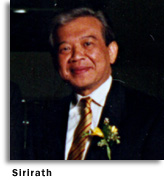 Claude Welch, SUNY Distinguished Service Professor in the Department
of Political Science who has served as Lebun's mentor, describes her as
a young woman with joie de vivre, "who grows with every single
experience that comes her way."
Claude Welch, SUNY Distinguished Service Professor in the Department
of Political Science who has served as Lebun's mentor, describes her as
a young woman with joie de vivre, "who grows with every single
experience that comes her way." 
She is a 22-year-old Cambodian-American, a student in the Educational Opportunity Program who will receive a bachelor of arts degree with a major in political science from UB next month and she has a fire in her heart.
 Claude Welch, SUNY Distinguished Service Professor in the Department
of Political Science who has served as Lebun's mentor, describes her as
a young woman with joie de vivre, "who grows with every single
experience that comes her way."
Claude Welch, SUNY Distinguished Service Professor in the Department
of Political Science who has served as Lebun's mentor, describes her as
a young woman with joie de vivre, "who grows with every single
experience that comes her way."
Lebun's life is informed by a deep love of the ancient and exquisite Cambodian homeland she hasn't seen since she was 5 years old. The depth of her feelings toward her cultural heritage was behind her drive to conceive and develop a special program held at UB on April 17 to celebrate one of the loveliest and most ancient of Cambodia's performance arts.
"The Living Ancestor," a performance by the Cambodian American Heritage Dancers, was presented through Lebun's efforts to an enthusiastic audience of 500 in the Center for the Arts. She raised more than $10,000 to bring her dream to fruition on the eve of her graduation, fighting, she said, "to retain my own strong, clear vision of what this program should be."
 The performance, which married classical Cambodian dance forms with
a medley of American dance elements, was co-sponsored by the Faculty of
Arts and Letters. It is what Lebun called "her legacy and gift" to the
university that has educated her and provided her with the educational
tools for a lifelong career.
The performance, which married classical Cambodian dance forms with
a medley of American dance elements, was co-sponsored by the Faculty of
Arts and Letters. It is what Lebun called "her legacy and gift" to the
university that has educated her and provided her with the educational
tools for a lifelong career.
The audience included the Honorable Sisowath Sirirath, Ambassador Extraordinary and Plenipotentiary and permanent representative of the Kingdom of Cambodia to the United Nations, and John McAuliff, executive director of the United States-Indochina reconciliation project, both of whom spoke to the audience about Cambodia's recent history.
At the performance, Lebun was presented with an award from the university's Diversity Committee in recognition of her contributions to tolerance and diversity on campus and for the creativity and leadership she demonstrated in spearheading the endeavor.
The dance troupe is one of several in the U.S. composed of Cambodian refugee artists who have dedicated themselves to the preservation and perpetuation of classical Cambodian dance, despite overwhelming odds. They are, like Lebun, the rare and fortunate survivors of one of contemporary history's most appalling reigns of terror, the genocide of nearly one-third of the Cambodian population between 1975 and 1979 under Pol Pot's psychopathic Khmer Rouge regime.
To place Cambodia's cultural loss in perspective, it is estimated that only 300 of some 380,000 Cambodian intellectuals and artists of all kinds survived the death marches and concentration camps during that terrible time, part of which was depicted in the film, "The Killing Fields." Among the dead were 80-90 percent of Cambodia's world-renowned classical dancers.
Among the millions who died was Lebun's father. Her mother escaped to Thailand with Lebun and her older brother. They were interned in the Phanat Nikhom refugee camp for 3 1/2 years until being released for emigration to the United States.
After being raised in the United States, Lebun enrolled at UB. In 1994, she traveled to Thailand under the World Learning Summer Abroad Program, "to give back to the Thai people what they had once given to me," she said, "and to find my identity...lost during my childhood years in the camp." Unexpectedly, she was assigned to teach English to refugees living in the Phanat Nikhom refugee camp, for which she still expresses enormous gratitude.
Last summer, she served an internship with Ben Kiernan, director of the Cambodian Genocide Program at Yale University, one of America's foremost authorities on modern Cambodia. At Yale, she read and translated transcripts of interviews with survivors of the genocide and catalogued the cases of execution at the Khmer Rouge extermination center at Tuol Sleng in Phnom Penh.
"I emerged from this experience deeply shaken," she said, "and convinced that promotion of cross-cultural understanding and universal human rights is the answer to atrocities such as this one." After that experience, and inspired by the artistic contribution of Maya Ying Lin, the Vietnamese- American designer of the Vietnam Veterans' Memorial, Lebun decided to honor the Cambodian dead and the country's living culture by introducing the Cambodian American Heritage Dancers to the UB community.
After graduation, she plans to return to her homeland to work for a year as an administrator in the Cambodian government and then to attend law school in the U.S., perhaps at UB, in preparation for a career in international diplomacy.